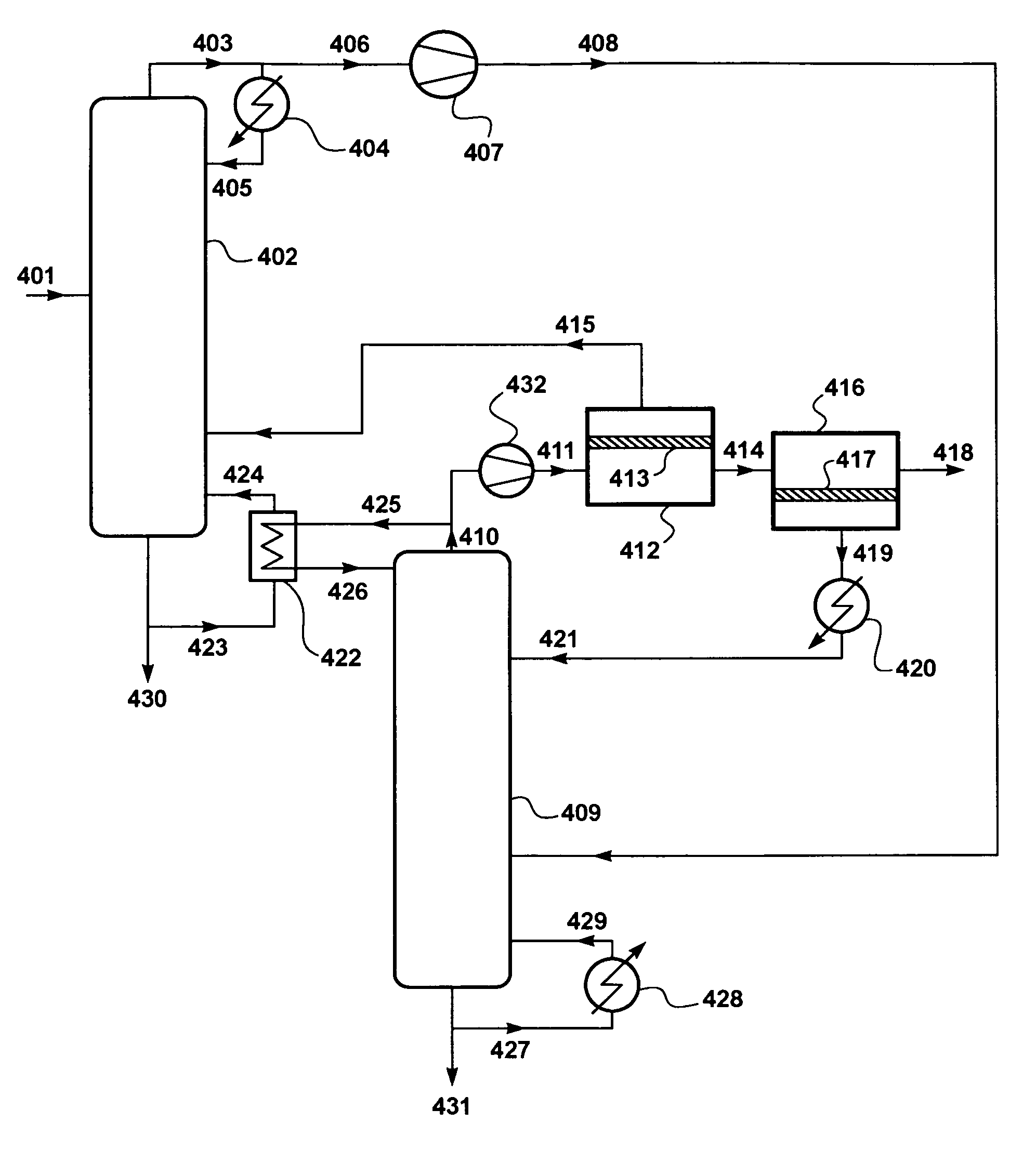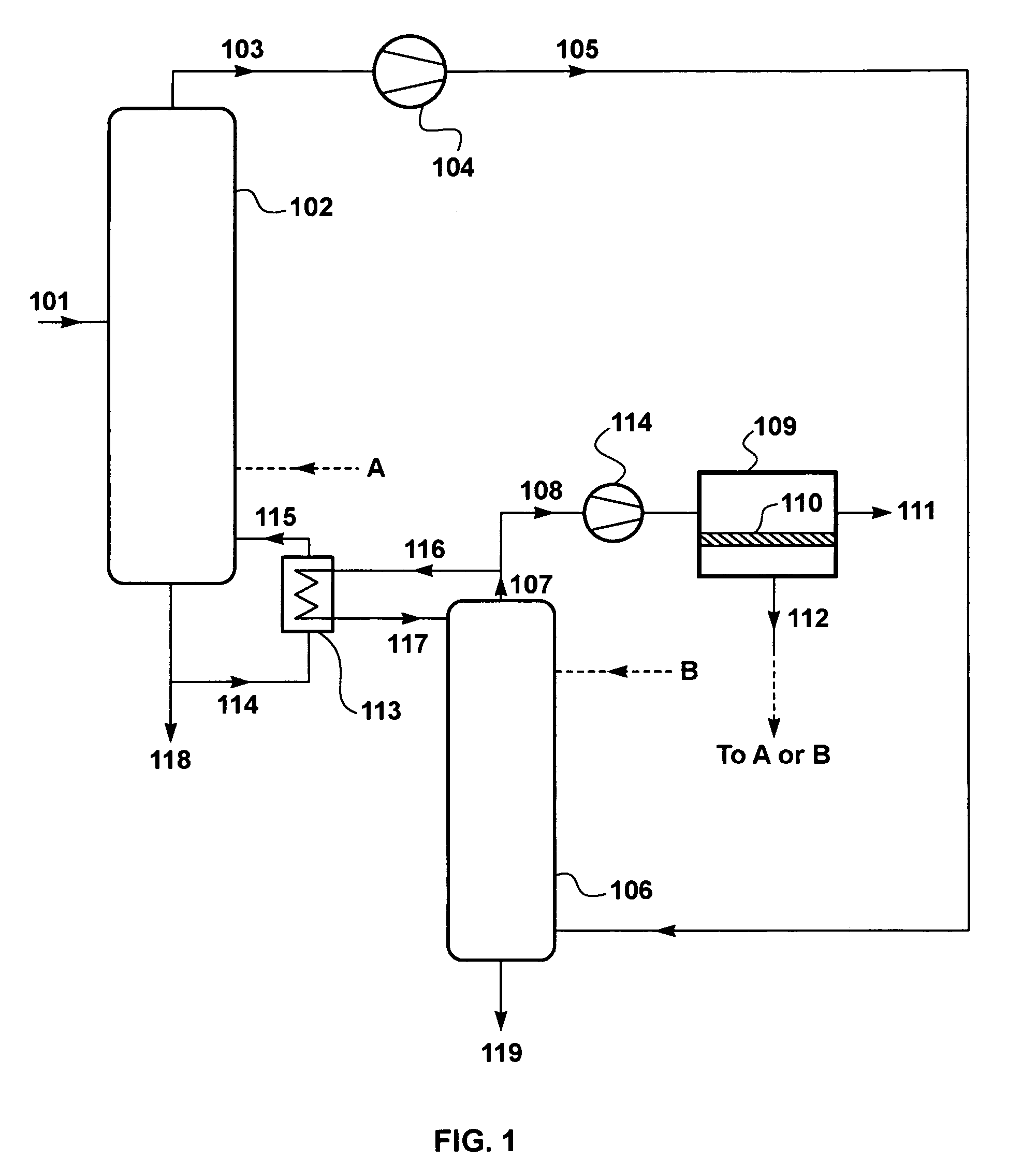Membrane-augmented distillation with compression to separate solvents from water
a membrane-augmented and solvent technology, applied in vacuum distillation separation, carboxylic compound preparation, separation process, etc., can solve the problems of high cost and complicated production of dry solvents from raw aqueous mixtures, and achieve the effects of low energy consumption, increased flexibility in heat exchange choices, and reduced cos
- Summary
- Abstract
- Description
- Claims
- Application Information
AI Technical Summary
Benefits of technology
Problems solved by technology
Method used
Image
Examples
example 1
[0173]A computer calculation was performed with a modeling program, ChemCad 5.5.1 (ChemStations, Inc., Houston, Tex.) to illustrate the process of the invention in the embodiment shown in FIG. 3, except that the product stream, 321, was assumed to be condensed by heat exchange against incoming feed, 301.
[0174]The calculation assumed that the feed composition was 11.5% ethanol and 88.5% water, representative of a raw feed from a bioethanol manufacturing process. The process was assumed to use a stripping column, having 15 stripping stages and a rectification column, having 15 stages also. The columns were assumed to operate at 0.5 bar and 3 bar respectively. The bottom stream, 317, from the second column was assumed to be recirculated to the first column.
[0175]The process was configured to provide a rectified overhead stream, 311, containing about 85 wt % ethanol, and a dehydrated product stream, 322, containing 99.7 wt % ethanol. The membranes were assumed to have a selectivity for ...
example 2
[0179]A computer calculation was performed using the same basic assumptions as for Example 1. In this case, however, it was assumed that the second column is also equipped with a small reboiler, so that the bottoms stream from this column is essentially pure water and is discharged, not recirculated. The results of the calculations are summarized in Table 2.
[0180]
TABLE 2Stream311322301(Rectified(Product(Feed)305overhead)314317318ethanol)Flow (kg / h)165,00030,12027,4738,58411,232134,88018,888Temp (° C.)371901131111348147Pressure (bar)1.03.03.00.13.00.53.0ComponentWater88.537.515.047.399.999.90.3Ethanol11.562.585.052.70.10.199.7
[0181]The addition of the small reboiler made almost no difference to the total energy usage, which was 53.7 million Btu / h.
example 3
[0182]A computer calculation was performed using the same basic assumptions as for Example 1. In this case, however, it was assumed that the first column is equipped with a reflux condenser to provide rectification in the column. The results of the calculations are summarized in Table 3.
[0183]
TABLE 3Stream311322301(Rectified(Product(Feed)305overhead)314317318ethanol)Flow (kg / h)165,00040,96627,4878,58922,071146,10918,898Temp (° C.)371421101111118155Pressure (bar)1.03.03.00.13.00.53.0ComponentWater88.520.015.047.336.999.90.3Ethanol11.580.085.052.763.10.199.7
[0184]The addition of the reflux condenser increased the total energy usage of the process to 69.0 million Btu / h, although the amount of high purity ethanol recovered increased very slightly.
PUM
| Property | Measurement | Unit |
|---|---|---|
| pressure | aaaaa | aaaaa |
| pressure | aaaaa | aaaaa |
| pressure | aaaaa | aaaaa |
Abstract
Description
Claims
Application Information
 Login to View More
Login to View More - R&D
- Intellectual Property
- Life Sciences
- Materials
- Tech Scout
- Unparalleled Data Quality
- Higher Quality Content
- 60% Fewer Hallucinations
Browse by: Latest US Patents, China's latest patents, Technical Efficacy Thesaurus, Application Domain, Technology Topic, Popular Technical Reports.
© 2025 PatSnap. All rights reserved.Legal|Privacy policy|Modern Slavery Act Transparency Statement|Sitemap|About US| Contact US: help@patsnap.com



